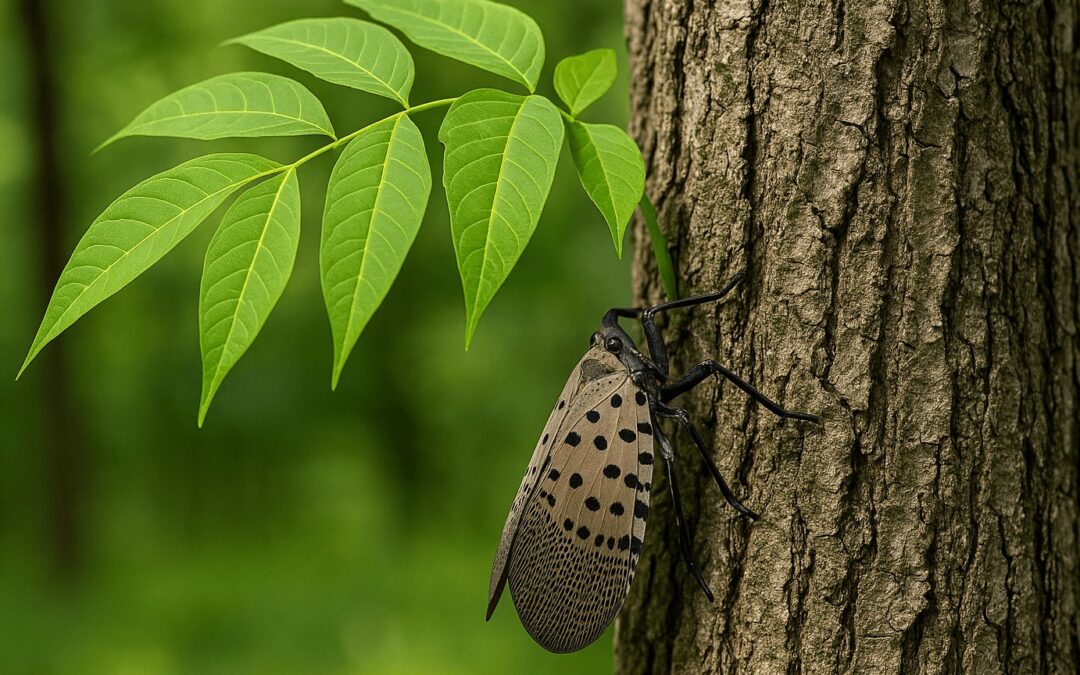Michigan’s forests and agricultural lands are facing a growing ecological threat: a duo of invasive species from eastern Asia—the tree of heaven (Ailanthus altissima) and the spotted lanternfly (Lycorma delicatula). Their partnership has serious implications for forest health, fruit crops, and rural livelihoods.
1. What Makes This Duo So Dangerous?
The tree of heaven, introduced centuries ago, has become notorious for its rapid growth and aggressive spread. Capable of producing up to 300,000 seeds per year, it releases chemical compounds that inhibit neighboring plant growth—a phenomenon known as allelopathy—and can resprout readily when cut, making control difficult.
The spotted lanternfly arrived in the U.S. around 2014 and has since spread to many eastern and midwestern states. Michigan confirmed its first sightings in 2022. The insect favors the tree of heaven as its primary host—feeding on its sap, laying egg masses on its bark, and multiplying in its shade.
While studies show that the lanternfly rarely kills native trees directly, it can devastate orchard and forestry productivity by inflicting sap-draining damage and producing sticky honeydew, which fosters black sooty mold and draws nuisance insects like ants and wasps.
2. Why It Matters for Forest and Agricultural Health
- Forest biodiversity declines: As tree of heaven spreads aggressively, it displaces native vegetation.
- Crops at risk: Spotted lanternfly feeds on grapes, apple trees, hops, maples, walnuts, and other valuable species.
- Economic impact: Honeydew-related mold and insect swarms can reduce fruit quality, interfere with harvesting, and diminish recreational enjoyment.
- Challenging control strategies: Both invaders have resilience—tree of heaven rebounds easily, and lanternflies hitchhike long distances via human activity (vehicles, firewood, etc.).
3. What Forest Managers and Landowners Can Do
Effective control relies on integrated, multi-pronged efforts:
- Monitor and report sightings: Citizens are encouraged to photograph, squash, and report spotted lanternflies to Michigan’s Department of Agriculture or regional invasive species networks.
- Scrape and destroy eggs: Lanternfly egg masses resemble gray, putty-like blobs. Scrape them into a bag, then soak in alcohol or hand sanitizer.
- Use chemical treatments cautiously: Pyrethroid insecticides or dinotefuran can provide rapid knockdown, especially after trees finish flowering (typically by end of July).
- Control tree of heaven effectively: Herbicide application directly to roots, foliage, or stump cuts after July can curb its resilience—but caution is essential due to its toxic sap and allergenic pollen.
- Support biocontrol research: Researchers are exploring fungal pathogens delivered via lanternflies and other vibration-based trapping methods to suppress populations.
Regional Example: Ohio
Ohio has seen rapid spotted lanternfly spread since its first confirmed case in 2020. Infestations have been reported in both rural vineyards and urban green spaces, with the tree of heaven acting as a major highway for lanternfly reproduction. State officials encourage residents to check vehicles, trailers, and outdoor equipment before traveling to reduce unintentional spread.
Regional Example: Pennsylvania
Pennsylvania was the first U.S. state to detect the spotted lanternfly in 2014 and remains one of the hardest-hit areas. The pest has significantly impacted the state’s grape and hardwood industries, prompting extensive quarantine zones and aggressive public awareness campaigns. Lessons from Pennsylvania’s early battles have shaped management strategies now being used across the Midwest.
Related Video: Understanding the Threat
Here’s a helpful video overview explaining how these two invaders interact and why they pose such a threat to Michigan’s ecosystems:
Moving Forward
Working forests depend on resilience. The tree of heaven and the spotted lanternfly may be invasive, but coordinated action—from monitoring and reporting to targeted removal and research—can reduce their hold on forest landscapes. With strategic management, it’s possible to protect native ecosystems and keep Michigan’s forests and orchards healthy.
